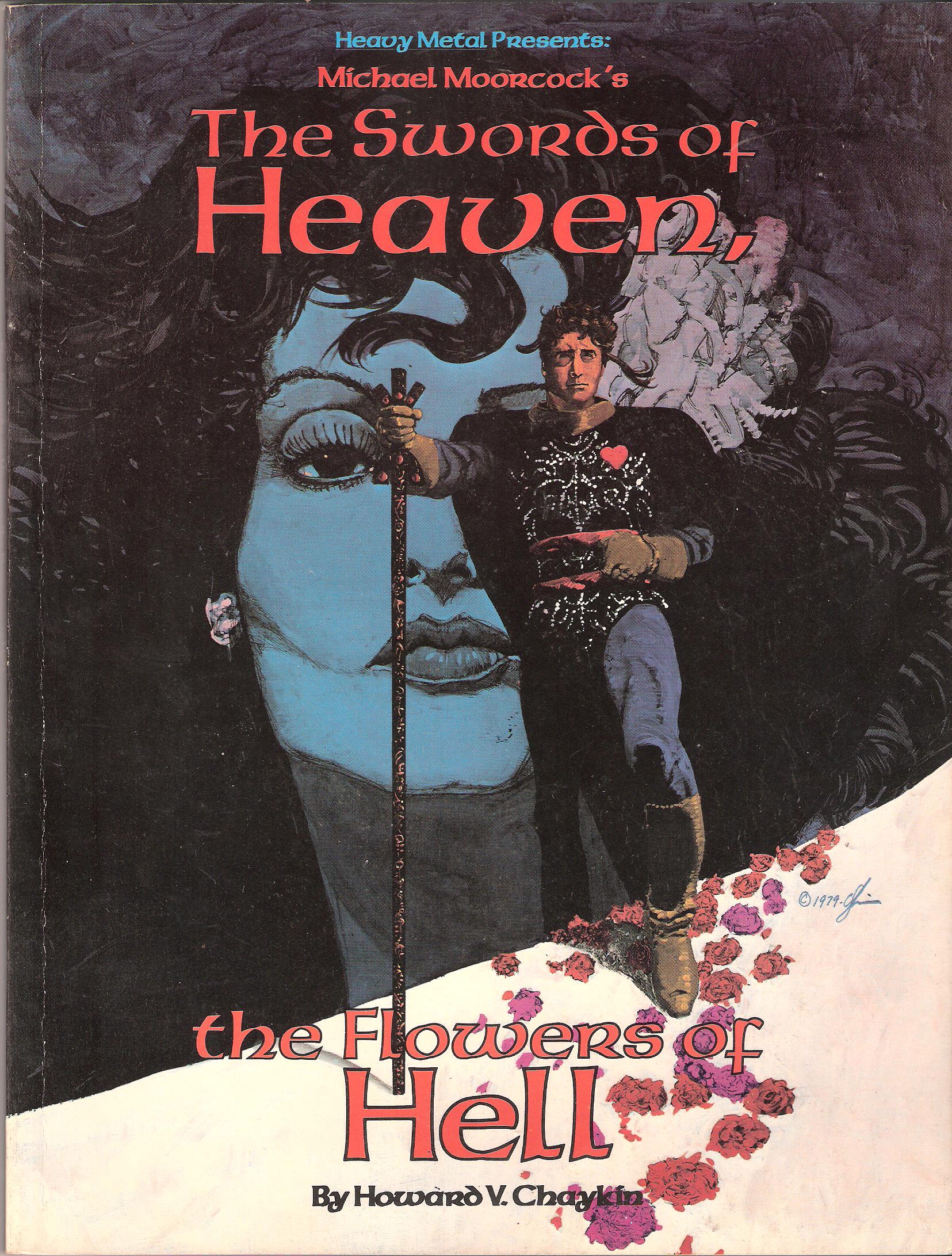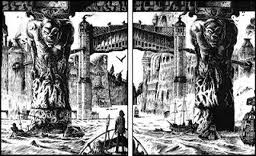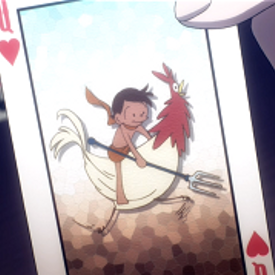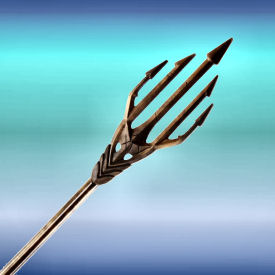So…where were we?
This is the second installment of what will (probably) be a three-part article about author Michael Moorcock’s work and comic books. You can read the first part here, or you can jump right in this part. We’re nothing if not flexible…
Elric of Melnibone isn’t the only one of Moorcock’s creations to be featured in comic book form. In addition to the guest appearances mentioned last time, both Dorian Hawkmoon and Prince Corum starred in their own comics.
Strictly speaking, the adventures of Dorian Hawkmoon are science-fantasy, rather than sword-and-sorcery. In the distant future, the evil empire of Granbretan is attempting to conquer the Earth. Count Brass, from the territory known as the Kamarg, is attempting to unite Europe against the Granbretans.
In order to spy on the Kamarg, the Granbretans embed a device resembling a black jewel into the forehead of Dorian Hawkmoon, a young man captured in a previous battle. The jewel, a hybrid of magic and technology, will force Hawkmoon to follow orders, or destroy his brain. At least, that’s what the Granbretanian sorcerer-scientists believe…
I think Elric of Melnibone deserves all the praise he gets, but I’ll always have a soft spot for Dorian Hawkmoon. He doesn’t brood as much as Elric, and the mixture of science and sorcery in his world leads to some great visuals. (The Kamarg’s forces fly into battle on the backs on giant flamingos, to pick just one example.) In some ways, Hawkmoon is easier to adapt into comic book form than Elric.
The Jewel In the Skull, the first novel in the Hawkmoon series, was adapted the first time in 1978 by writer/artist James Cawthorn, who collaborated with Moorcock several times. Cawthorn also adapted the second and third novels in the series. I’ve never seen those graphic novels, but I do have the adaptation of “Jewel” and I think it remains one of my favorite Moorcock comics.
The art is in black-and-white, which will cause some fans to dismiss the book immediately, some elements of the production look pretty primitive. Some of the captions look like they were produced on a typewriter, then pasted on the page. The black-and-white art works for me though. It makes Granbretan look even scarier and more oppressive (as I hope the image on this page illustrates.) And Cawthorn doesn’t use word balloons; he presents the dialogue as captions, Prince Valiant-style, which helps to give the story an epic feel.
In the novels, Moorcock says that the Granbretans hide their face behind ornate masks, carved to resemble various animals. Cawthorn keeps these masks, while the next adaptation changes them to elaborate helmets. It isn’t hard to understand why this happened; with the faces exposed, the artist can show a full range of expressions. But the helmets are just plain scarier.
The next adaptation of The Jewel In the Skull came from an American publisher, First Comics, in the late 1980s. This was followed by adaptations by the next three novels in the series: The Mad God’s Amulet; The Sword of the Dawn and The Runestaff. Each of these was marketed as a four-issue limited series. Veteran comics writer Gerry Conway scripted the first two adaptations, followed by Roger Salick. Rafael Kayanan was the penciller for the entire run of the comic, working with a variety of inkers.
First was a leading independent publisher during the early growth years of the direct sales comic market. Its list of creator-owned titles included American Flagg; Jon Sable, Freelance and Grimjack. American Flagg was a science fiction title that (I think) was nominated for a Nebula award during its first year of publication. Grimjack worked through a variety of genres, which included occasional echoes of Moorcock’s work. The main setting for this series was Cynosure, the city at the center of all dimensions, similar to Moorcock’s Tanelorn. Early in the series, Grimjack notes in passing that he once encountered a traveler who thought he was in Tanelorn.
In addition, First was the comic book home of the Eternal Champion during the late 1980s. Along with the Hawkmoon comics, it published books featuring Elric and Corum.
Visually, Corum Jhalen Irsei, sometime known as the Prince in the Scarlet Robe, bore a strong resemblance to Elric . His Earth, however, was significantly different. There were two non-human races, the Vadhagh and Nhadragh, and, unlike the Melniboneans, they did not fall due to their own decadence (at least not entirely). They were obliterated by human race, who Moorcock calls the Mabden here.
Corum, one of the last of the Vadhagh, is captured and tortured by a Mabden warlord, Glandyth-a-Krae. He escapes, and is nursed back to health by the Mabden woman Rhalina, but he’s lost a hand and an eye. In order to strike back at Glanyth-a-Krae, he acquires two supernatural artifacts: the Eye of Rhynn and the Hand of Kwyll. The Eye enables Corum to look into other dimensions, while the Hand gives him the power to summon creatures from these dimensions.

Like the Elric and Hawkmoon books, the Corum comics adapt Michael Moorcock novels. In this case, four novels are adapted: The Knight of Swords; The Queen of Swords; The King of Swords and The Bull and the Spear. The first three limited series were scripted by Michael Baron, the creator of off-beat super-heroes like Nexus and the Badger. The art for “Knight” and “Queen” was contributed by Mike Mignola, before he went on to a different type of fantasy and created the demon-fighting Hellboy. He continued to provide covers for the “King of Swords,” while Ken Hooper took over the interior art. (The image on our front page is from a Mignola cover).
The Bull and the Spear was adapted by writer Mark Shainblum and artist Jill Thompson.
While these comics were all adaptations of pre-existing novels, Moorcock plotted an original story in the late 1970s for writer/artist Howard Chaykin to develop. The story was published by Heavy Metal as The Swords of Heaven, the Flowers of Hell, in what was known at the time as the graphic album format. A graphic album is a paperback book with the approximate dimensions of a record album. What’s a record album? Never mind; forget I said anything…
The hero is this story comes from a thread of the Eternal Champion saga that still hasn’t been given much exposure in comics. This facet of the Champion goes through multiple reincarnations and is aware of his previous lives. He starts as Erekose in the novel The Eternal Champion and he appears as Erekose in The King of the Swords (He’s the bearded chap in the Mignola cover I mentioned earlier). He then turns into Urlik Skarsol for The Silver Warriors (also known as Phoenix In Obsidian) In The Swords of Heaven, The Flowers of Hell, he becomes Clen of Clen Gar, a warrior caught in the middle of war he doesn’t really understand.
Chaykin’s credits range from his own creation, American Flagg, to adapting Fafhrd and the Grey Mouser and Buck Rogers. “Swords” is well-plotted and beautiful visually. This story also marks one of the earliest appearances of the Angels, creatures that play a role in some of Moorcock’s later novels.
In his introduction, Moorcock declares that this is going to be the last story of the Eternal Champion. I’m glad he was wrong and I hope he is too.












Recent Comments